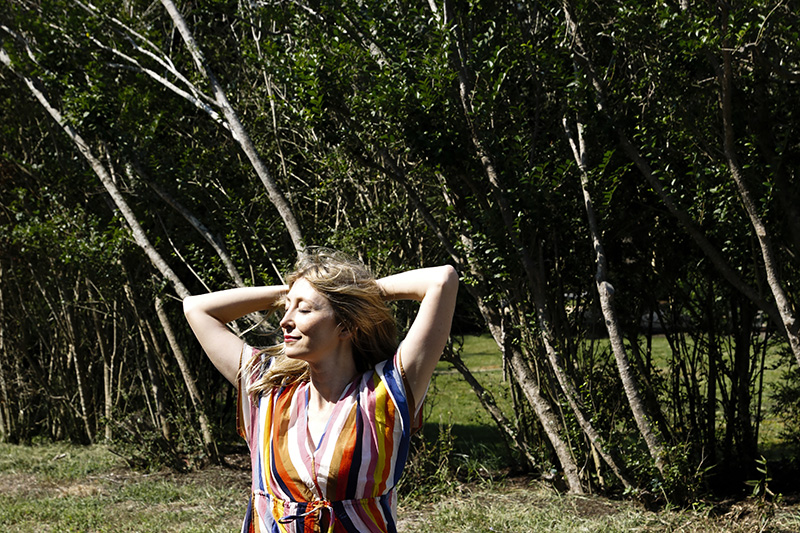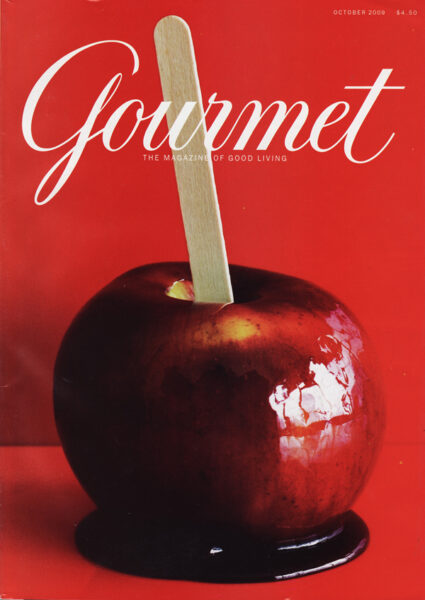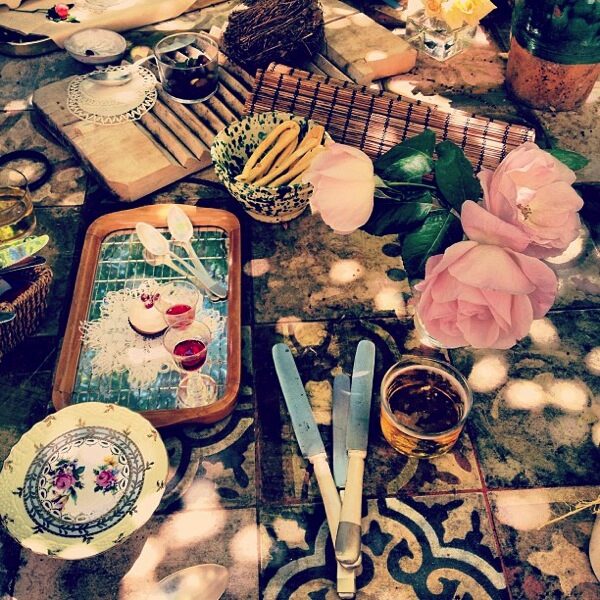The radical act of releasing judgment

One thing they don’t tell you about having a baby is that the day after you wake up in a whole new body. This shouldn’t be surprising. After all, for the last nine months, your body was also a one-room studio apartment, complete with a 24-hour cafeteria. (Once the occupant moves out, the 24-hour cafeteria stays open, just in a new location.)
When I was newly pregnant, I asked my best friend (who had recently had her third) about what happens to your body after. “Things more or less end up back in the same place,” was all she would say.
More or less.
“Losing the baby weight” was a thing on my mind. It was one of the few aspects of the post natal experience that does get talked about regularly, whether by women in gossip sessions (”Did you see Natalie? OMG, looks like she’s still pregnant”) or on the covers of tabloids, who venerate the celebrity moms that “bounce back” (thanks to their personal chefs and personal trainers) in less than a month, and shame both those with the poufy mid-sections and those who resort to tummy tucks in equal measure.
The Radical Act of Releasing Judgment
The thing is, the whole experience of pregnancy had been a miracle to me. After so many rounds of fertility treatments, and having to come to grips with the fact that I might never carry my own child, I entered pregnancy with a bone deep sense of gratitude for my body and what it was capable of. I had lived so long in the realm of uncertainty that the normalcy of my pregnancy was almost shocking. Doctors’ appointments were thrilling in their banality — “Everything looks normal. See you in four weeks.” That’s it? What a gift that most people never know they have.
So on one hand, my body, sliced open in 6 layers for a planned C-section and stitched back together, carrying 35 more pounds than it was accustomed to, felt like a state of being I was eager to move on from. And yet, I was determined to find a way to be as kind to this body as I had been when I was pregnant.
The Body is Not an Apology
At this point, I stumbled upon Sonya Renée Taylor’s brilliant The Body is Not an Apology, which not only upended my view of body shame and body positivity, but also helped clarify an intuition I’d had about what gets in the way of joy in adult life.
Taylor frames body shame as an internalized understanding of a societal framework around what defines a “good” body. This framework is shaped by patriarchy, white supremacy, ableism, ageism, and other factors. This yields a standard that is white or light-skinned, thin, youthful looking (so no wrinkles, gray hair, or visible signs of aging), abled, etc. Bodies that conform to these standards are considered “attractive,” bodies that don’t are deemed unattractive or ugly. You can see how patriarchy clearly figures in here.
Male bodies are most socially acceptable when they display attributes that project power. Such as being tall and visibly muscled, perhaps having facial hair. Female bodies are most socially acceptable when they display attributes that are considered desirable to men. Such as thinness, larger breasts, youthfulness — because in a patriarchal society, women are valued based on their desirability to men. Have a body that violates these conditions, and you may be made to feel different, or worse.
There’s no formal apparatus that enforces this body hierarchy.
It’s upheld in thousands of tiny, daily acts: who we compliment, what we beat ourselves up for, who gets cast in lead roles and put on magazine covers, who gets made fun of on the group text or the late night comedy monologue, what beauty products get carried at the drugstore, what gets turned into a meme. It’s an entirely decentralized form of tyranny. No one person can be blamed. It’s just the way things are.
But what I didn’t realize until reading this book is how easy it is to disclaim these blatant standards out in the world while still holding on to the unconscious conditioning they have baked into our psyches. I can say, “It’s absurd that the process of labor transforms a woman’s body from gorgeous and magical to disgusting in a matter of hours.” And at the very same time I can be standing on a scale. Feeling like utter crap to see the number on the display unchanged from a week ago. And then beat myself up for beating myself up about it.
Body shame in different forms
The thing I suddenly understood is that the beliefs I held about my body almost always came in the form of messages about other bodies. A ballet dancer mother who told me that as a rule it was always better to be underweight than over. The magazines I loved reading as a teen that treated a size-6 body as a “normal girl” with the understanding that she was not in the same league as a model. The women around me who were always dieting. The adage, “Nothing tastes as good as being thin feels.” The scale in the bathroom that literally says THINNER on it, in type that looks like it’s wasting away as the word progresses.
The casual derision from adults in my life toward fat people. Whether it was comments about what they ate in a restaurant or that their clothes were unflattering. The doctor’s admiration that my weight remained unchanged from the last visit. The pity an adult might express about a “chubby” friend. (What could I think but how important it was to avoid that fate?)
My point is that you could spend your life only hearing kind messages about your body and still have a crippling case of body shame, because of what you heard about other bodies.
And here’s where we level it up. (Thanks for your patience.)
Just as our ability to find our bodies beautiful gets limited by the ideas of beauty we absorb from around us, our ability to find joy can be constrained by the value judgments we’ve been steeped in since childhood.
And it does start in childhood. The classmate that received an award for sitting still and being attentive. The classmate who was written off by the teacher as a class clown and always ended up in detention. The pat on the back you received for getting good grades. The stern look you got when you laughed too loudly. Overhearing your parents gush about their friends’ kid who got into Harvard. Overhearing your parents gossiping about a friends’ kid who was going to art school. Being celebrated when you pulled an all-nighter and got an A on test. Being called lazy when you slept in on the weekend. The compliant, rule-following sibling who was showered with affection. The playful sibling who was always in trouble for “not taking things seriously.”
When you were a child, what were you or other kids around you praised for?
- Doing what you were told without question?
- Keeping your room neat and tidy?
- Being quiet when out in public?
- Wearing clothes your parents thought were flattering and appropriate?
- Putting others’ needs before your own?
- Not making a fuss, even when you were unhappy about something?
The things we were praised for tell us what the authority figures in our lives believed were valuable — and what wasn’t.
Chances are you and your friends weren’t praised for…
- Making each other laugh really, really hard
- Teaching yourself a silly dance
- Having so much fun that you lost track of time
- Decorating your room in a way that reflected your personality
- Eating dessert first
- Making a mess trying something new
- Putting in a big effort on an artwork that ultimately didn’t turn out the way you wanted
- Taking time for yourself
Many of the behaviors that bring us joy, or help protect our joy, aren’t considered worthy of praise. We don’t praise people for holding a boundary or resting. We don’t praise kids for losing themselves in play (we’re more likely to call it “wasting time”). So even if you weren’t punished for these things, as you grew up, you likely internalized the idea that they’re frivolous, unimportant, foolish, or even selfish.
And if you were applauded for skipping a fun outing to do a research paper or you were praised for being competitive and tough instead of just having fun on the soccer field, this cemented the message even further.
That joy is a distraction from success. Joy is disruptive. Joy is lazy and self-indulgent. Joy is weak. Joy is bad — and if I let myself have too much of it, I’m bad too.
What I didn’t fully appreciate until I read Taylor’s book is how far-reaching the effects of this conditioning can be. As she writes: “I am not simply proposing that you make peace with your body because your body shame is making you miserable. I am proposing you do it because it’s making us miserable too. Your children are sad that they have no photos with you. Your teenager is wondering if they, too, will be obligated to hate their body because they see you hating yours. The bodies you share space with are afraid you are judging them with the same venom they have watched you use to judge yourself.” [Emphasis mine]
Our relationship to our bodies influences the way that people close to us relate to their bodies, especially children. And in the same way, our relationship to joy can either shame or encourage others in their pursuit of it.
When you treat your hobbies like wasted time, not only do you get less pleasure out of them, but your children learn that they’re supposed see hobbies as wasted time too. When you joylessly slog through volunteer work that’s not a fit for you, you send the message that contributing means sacrifice, not joy. When you constantly criticize small mistakes in your creative work, you make others afraid of what you’ll think about theirs.
The act of releasing judgments
But every time you defy these judgments, you help to dismantle the conditioning that keeps them entrenched in our culture. This is why joy has such power. Joy can attack fatphobia, workaholism, ageism, perfectionism, transphobia, and a host of other unwritten rules of society.
When you let others see you confidently wearing something you love that doesn’t meet the conventional definition of “flattering,” you chip the facade of “flattering” for everyone you encounter. When you opt out of hustle culture to play with your kids on a Tuesday afternoon, you’re giving your coworkers and your kids a different model of what it means to live well. When you, a masculine-presenting individual, wears nail polish because you like the colors, you create a cognitive dissonance that makes it easier for others (including those more vulnerable than you) to do so too. Sometimes we can’t even know these things are possible until we see them.
I suppose what I’m saying is, if you won’t nurture your joy for yourself, do it for others.
I think of this every time one of those old body shame scripts pops up in my head. If I’ve been on a straight pizza-bacon-fries rotation for days and Albert offers me a bite of ice cream, I can’t deny that the first phrase that pops into my head is “I can’t. I’ve been so bad lately.” But I refuse to condition my child to believe that eating makes you bad. So I back up and decide whether I really want it, and if not, I just say, “I’m good.”
By the same token, I’m determined that our kid should see us enjoying our lives as much as he sees us striving to improve them. And so this means overriding the conditioning that tells me my work is my worth and that every spare minute should be used productively. It means going for a run even when I feel guilty that I should be spending time with him. It means letting him see me sing and dance with full abandon, even when I don’t think I’m very good at it. It means being visibly, wondrously enthralled by the world as often and as loudly as possible.
Conclusion
I have always said that this project on joy, whatever it is, has an individual and a collective component. Here we celebrate the community initiatives to paint crosswalks and school buildings. And we cheer for the things you do in your home to bring vibrancy and joy to your life. When I first started giving big talks about how to create more joy in workspaces or public places, I was often surprised to find that most people who came up to talk to me after were more interested in applying these ideas in their own lives, rather than their work. Now I understand that each of these feeds the other. Creating a more joyful world makes it easier for us as individuals to find joy within it. And by bucking disapproval to embrace joy, we make it easier for others to see the potential for joy in themselves too.




Discussion (11 Comments)
A fabulous article. Thank you. At 68, it’s not too late, though it’s not easy to overturn the dominant thoughts regarding weight, aging, and taking playtime. Thank you
Thank you Ingrid. I enjoy your writing. I appreciate your genuineness, courage, and intellect. Joy isn’t silly. It’s absolutely necessary to a meaningful life. You’re work is so important! Hooray for you!
Thanks, Ingrid, for another thought provoking read. I was raised at a time when one was praised for ‘colouring inside the lines’, a term I use often to sum up societal rules of what is normal. At 59 I try not to berate myself for colouring outside those lines and exploring things that bring me and those around me joy. As I was writing this comment, a beautiful fox walked past the window, my former me would continue to write, the more new me got up and took more notice of Mr/s Fox as they hunted for breakfast.
Thank you again for continuing your research and sharing your observations!
Thanks for showing us another way we sap joy from ourselves and each other. I completely agree that even if we’re pretty okay with our bodies, when you hear someone else complain about theirs, it automatically makes you think about your own and start comparing (and comparison truly is the thief of joy). Wouldn’t it be nice if we could spend more time just enjoying what we have instead?
The most wonderful thing about our bodies are what they let us do. When I took a friend to hospital I waited by the entrance. So many people struggled to move without pain. It totally filled me with gratitude for the simple act of being able to walk freely. Amongst all the anxieties of how we look we forget how fortunate we are to cuddle our babies and walk around the room with them, type on a keyboard, go dancing or swimming without a second thought. Our bodies are miracles.
That reframe has worked well for me too. It’s wonderful to appreciate all our bodies can do. Still, many are disabled and find joy and wonder in their bodies. One thing I appreciate about Taylor’s work is her point that to be alive is an extraordinary thing, and given that, how could *any* body be the wrong vehicle for experiencing it? Every body is, as you say, a miracle!
Thank you for this article and info about Taylor’s book.
It’s one of the best things I’ve read in the last few years. Hope you enjoy it!
“And by bucking disapproval to embrace joy, we make it easier for others to see the potential for joy in themselves too.” I am going to sit with this line and try to buck as much disapproval as possible to embrace joy. It is hard to unshackle myself from the drudgery of “shoulding”. It is liberating to allow joy in , maybe it can be my superpower.
I love that. It absolutely can be your superpower, Carolyn!!
Thank you so much for your posts, particularly this one. I am 8 months post partum and undergoing tests as the pain I thought was pregnancy related is likely to be cancer returning in my body. Lately I have felt so let down by my body, but your post reminds me of the strength and power it actually possesses. Creating my 2 children who are the very definition of joy. Instead of ‘verbally’ beating my body up I will reflect on that strength and power, may it help with the healing process.